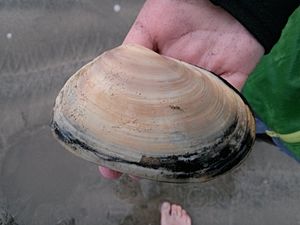Toheroa facts for kids
Quick facts for kids Toheroa |
|
|---|---|
 |
|
| Toheroa (Paphies ventricosa) at Oreti Beach, Southland, New Zealand | |
| Scientific classification | |
| Genus: |
Paphies
|
| Species: |
ventricosa
|
Paphies ventricosa, or toheroa, is a large type of shellfish. Its Māori name, "toheroa," means "long tongue." This special shell lives only in New Zealand. It is a kind of bivalve mollusc, which means it has two shells that hinge together. Toheroa belong to the family Mesodesmatidae.
Where Toheroa Live
Toheroa are found on both the North and South Islands of New Zealand. However, most of them live on the west coast of the North Island. They prefer wide beaches with fine sand. These beaches often have large sand-dunes nearby. Fresh water from these dunes seeps into the sea. This fresh water helps tiny plants called diatoms and other small living things called plankton to grow. Toheroa eat these tiny plants and creatures.
What Toheroa Look Like
The toheroa is a very big shellfish. It has a strong, white shell that is long and oval-shaped. The widest part of its shell is in the middle. The biggest toheroa found was about 11.7 centimeters (4.6 inches) long. It was about 8.1 centimeters (3.2 inches) tall and 3.8 centimeters (1.5 inches) thick.
Toheroa and People
For a long time, toheroa have been a popular seafood. People often use them to make a greenish soup. This soup is famous around the world.
Long ago, Māori moved toheroa to different parts of New Zealand. They used special bags called pōhā. These bags were made from a type of seaweed called southern bull kelp (Durvillaea poha).
In the 1950s and 1960s, too many toheroa were collected. Because of this, collecting them was banned in 1979. This ban is still mostly in place today. Only a small amount can be gathered for traditional Māori purposes. However, the number of toheroa has not grown back much since 1979. This is due to several reasons. Some people still collect them illegally. Also, some traditional collecting is not well managed. Cars driving on beaches can harm them. Pollution and less fresh water reaching the beaches also cause problems. A sickness called gas bubble disease also affects them.



